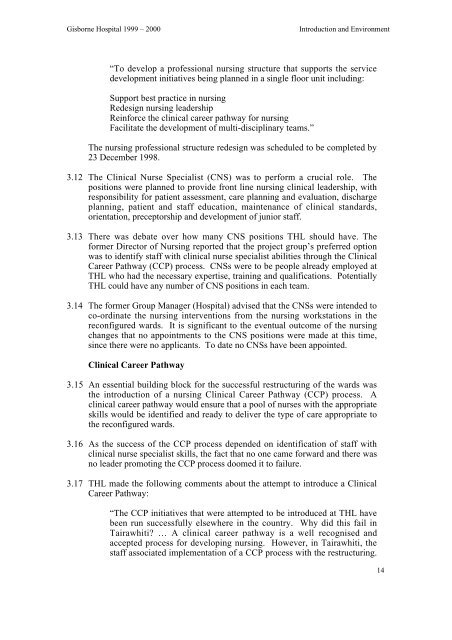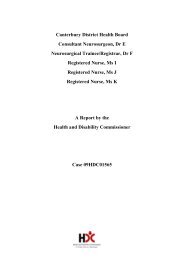Gisborne Hospital Report - Health and Disability Commissioner
Gisborne Hospital Report - Health and Disability Commissioner
Gisborne Hospital Report - Health and Disability Commissioner
You also want an ePaper? Increase the reach of your titles
YUMPU automatically turns print PDFs into web optimized ePapers that Google loves.
<strong>Gisborne</strong> <strong>Hospital</strong> 1999 – 2000<br />
Introduction <strong>and</strong> Environment<br />
“To develop a professional nursing structure that supports the service<br />
development initiatives being planned in a single floor unit including:<br />
Support best practice in nursing<br />
Redesign nursing leadership<br />
Reinforce the clinical career pathway for nursing<br />
Facilitate the development of multi-disciplinary teams.”<br />
The nursing professional structure redesign was scheduled to be completed by<br />
23 December 1998.<br />
3.12 The Clinical Nurse Specialist (CNS) was to perform a crucial role. The<br />
positions were planned to provide front line nursing clinical leadership, with<br />
responsibility for patient assessment, care planning <strong>and</strong> evaluation, discharge<br />
planning, patient <strong>and</strong> staff education, maintenance of clinical st<strong>and</strong>ards,<br />
orientation, preceptorship <strong>and</strong> development of junior staff.<br />
3.13 There was debate over how many CNS positions THL should have. The<br />
former Director of Nursing reported that the project group’s preferred option<br />
was to identify staff with clinical nurse specialist abilities through the Clinical<br />
Career Pathway (CCP) process. CNSs were to be people already employed at<br />
THL who had the necessary expertise, training <strong>and</strong> qualifications. Potentially<br />
THL could have any number of CNS positions in each team.<br />
3.14 The former Group Manager (<strong>Hospital</strong>) advised that the CNSs were intended to<br />
co-ordinate the nursing interventions from the nursing workstations in the<br />
reconfigured wards. It is significant to the eventual outcome of the nursing<br />
changes that no appointments to the CNS positions were made at this time,<br />
since there were no applicants. To date no CNSs have been appointed.<br />
Clinical Career Pathway<br />
3.15 An essential building block for the successful restructuring of the wards was<br />
the introduction of a nursing Clinical Career Pathway (CCP) process. A<br />
clinical career pathway would ensure that a pool of nurses with the appropriate<br />
skills would be identified <strong>and</strong> ready to deliver the type of care appropriate to<br />
the reconfigured wards.<br />
3.16 As the success of the CCP process depended on identification of staff with<br />
clinical nurse specialist skills, the fact that no one came forward <strong>and</strong> there was<br />
no leader promoting the CCP process doomed it to failure.<br />
3.17 THL made the following comments about the attempt to introduce a Clinical<br />
Career Pathway:<br />
“The CCP initiatives that were attempted to be introduced at THL have<br />
been run successfully elsewhere in the country. Why did this fail in<br />
Tairawhiti? … A clinical career pathway is a well recognised <strong>and</strong><br />
accepted process for developing nursing. However, in Tairawhiti, the<br />
staff associated implementation of a CCP process with the restructuring.<br />
14
















